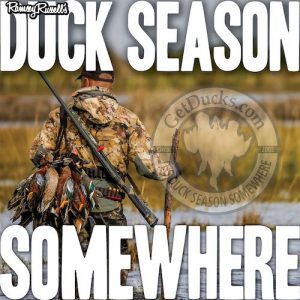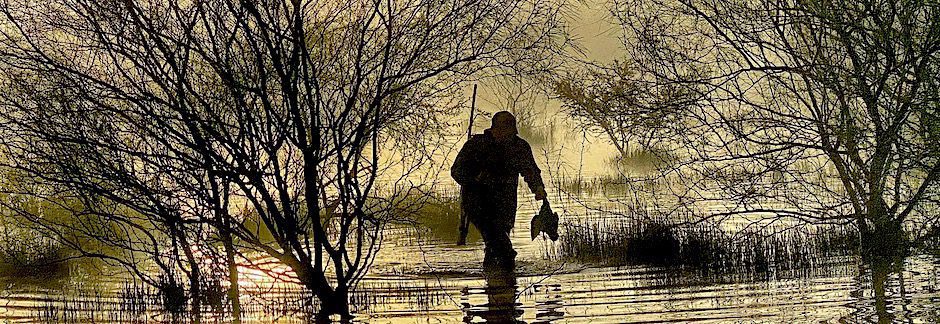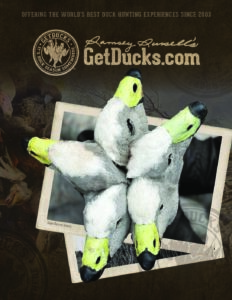MOJO’S Duck Season Somewhere Podcast
EP 411. Pacific Flyway Glory Days

The oldest waterfowl decoys on earth were discovered in the Pacific Flyway. There are century-plus-years-old hunting clubs, and pit blind hunting may have even originated there. Bull hunting was borrowed from a traditional Mexican trick of the trade for filling up the commercial meat wagon quickly—all those gold rushers had to eat after all. Then came the goose patrols. Former US presidents broke personal records. Hollywood A-listers and famous athletes, business people from far and wide, market hunters and market-hunters-turned-professional-guides, friends and neighbors — all flocked to Pacific Flyway wetlands in pursuit of waterfowl. Waterfowl hunting led Yancey Forest-Knowles and Wayne Capooth to individually research waterfowling’s storied past such that they became foremost authorities. Today they treat listeners to a rare glimpse into the Pacific Flyway’s dramatic waterfowling history.
Related:
Yancey Forest-Knowles and Wayne Capooth newest collaboration is “The Pacific Flyway: Historic Waterfowling Images.” They provide contact information in today’s episode.
EP 410. From the Vault: Lynyrd Skynyrd Remembered

On October 19, 1977, Lynyrd Skynyrd was inarguably the greatest rock band touring the USA and played what was their final concert in Greenville, South Carolina. While enroute to Baton Rouge on October 20th, their plane crashed in the remote southwest Mississippi woodlands, killing 6 passengers to include frontman Ronny Van Zant, guitarist Steve Gaines, and backup vocalist Cassie Gaines. Decades later, their classic southern rock ballads are remembered worldwide – and everyone has a favorite Skynyrd song! Lee Kjos describes why Skynyrd remains his all-time favorite band. We then visit personally with Ronnie Van Zant’s childhood friend and bodyguard, Gene Odom, and several Amite County, Mississippi locals who first responded to the crash. What was growing up in Jacksonville like for Ronnie Van Zant? How’d they develop their band name, what events inspired their lyrics, and what was it like touring with them? What kind of guy was Ronnie Van Zant and how would he likely have wanted to be remembered? What do first responders most remember about that day? What compelled them to privately fund and to recently construct a beautiful Lynyrd Skynyrd Monument nearby? Having met these guests and heard their stories, what’s Ramsey’s final take on it? All of these questions and some incredible never-before-told anecdotes in today’s very special from-the-vault episode of Duck Season Somewhere. We received tons of feedback when this episode first aired in 2020. Turn it up.
EP 409. The Tarpon Club and E.H.R. “Ned” Green

In 1899, the Tarpon Club in gulf-coastal Texas was the most expensive, expansive and exclusive club in the world, its membership dubbed the “First Four Hundred Sportsman of America,” whose combined wealth reached into the hundred-millions. Or so said E.H.R. “Ned” Green, the one-legged, prostitute-loving son of the richest woman in the world. Texas historian Rob Sawyer describes the Tarpon Club and other exploits of one of the wealthiest and most accomplished historical American figures you’ve never heard of! Truth is way stranger than fiction!
EP 408. Peru Duck Hunting (Part 1) with Jake Latendresse

We only thought we’d seen and done a lot together until videographer, Jake Latendresse and I went duck hunting in Peru. From nearly 16,000 feet high into the Andes Mountains for a handful of mountain waterfowl species found nowhere else on earth to along the Pacific Ocean at sea-level duck for cinnamon teal and white-cheeked pintail, every day was an absolute stand-alone adventure. But the incredible duck hunting was itself only the spear tip. It was the complete cultural immersion into ways of life we’d never before encountered that left an indelible impression. Jake’s behind-the-camera attention to detail makes him perfect for such adventures, and today he articulates this unique Peru duck hunting experience. Watch the Life’s Short GetDucks: Peru Duck Hunting video on GetDucks YouTube Channel (link below).
Related Links:
>>> Life’s Short GetDucks: Peru Duck Hunting Video (GetDucks YouTube Channel)
>>> Peru Duck Hunting (at GetDucks.com)
EP 407. Operation Stoned Duck (Part 3): The Aftermath

On October 17, 2007, the hammer finally came down on young Sam Necaise, who believed himself bulletproof. It came in the form of “every green game warden truck in the state of Mississippi and guys wearing FBI jackets.” Swinging that big hammer was Kennie Prince, lead undercover investigator of Operation Stoned Duck. Necaise and Prince each recall that fateful day from their own perspectives. And while the good guys won and Necaise was incarcerated for his crimes, the story was not over. Far from it. An amazing story of redemption, of faith and of friendship had, in fact, only just begun. You do not want to miss this final episode! I promise it will leave you with plenty to think about during the quiet moments between life’s volleys.
Related Link:
The Poacher’s Nightmare: Stories of an Undercover Game Warden
EP 406. Texas Barbecue Religion

It was right here–this exact location–in downtown Houston that I found smoke-infused religion. Purveyor of real Texas barbecue and former world-champ, Grant Pinkerton, and I visit at Pinkerton’s Barbecue, running through the finer points of beef versus pork ribs, brisket, whole hog cooking, world championship cook-offs and starting them young. Just in time for the upcoming season, he details tried-and-true, smoked-to-perfection methods, swapping favorite recipes for ducks, geese, doves and side dishes, too. Mouth-watering episode.
EP 405. Farming Rice and Ducks in the Garwood Prairie–But for How Much Longer?

Since arriving to Texas from Europe 4 generations ago, Slade Schiurring’s family has produced rice on Texas’s fabled Garwood Prairie. Waterfowl, too! It was his grandfather who returned from the Second World War and began leveeing the 3S Ranch property specifically for waterfowl. Slade describes his family’s long-standing commitments to both rice farming and to waterfowl conservation, telling how they each go hand in hand; how both have changed drastically. As the past meteorically collides with the future, a real battle for agricultural land, for duck habitat, for water–essentially for a since-forever way of life on the prairie–is raging. For how much longer might it even exist?
EP 404. Operation Stoned Duck (Part 2): “The Mouse”

Sam Necaise grew up deer hunting in south Mississippi with his dad. In many ways, his younger days remind me of my own. Maybe similar to yours, too. But big bucks were pretty tough to come by where he grew up–unless you knew a place where few people hunted. Because it was posted. And maybe folks willing to break a few little laws are willing to break bigger and more. Maybe the lines even start getting blurry. And maybe some folks even relish an outlaw reputation. Until the hammer falls. This is the second of a special 3-part series that you do not want to miss! Hang on, folks, this story might punch you in the gut on a few different levels.
Related Link:
The Poacher’s Nightmare: Stories of an Undercover Game Warden
EP 403. The Texas Sting, 1986

“It effects lives. Like tumbling dominoes, it affects relationships,” says Gene Campbell about the fateful event. Y’all know my friend, Gene Campbell of Oyster Bayou Hunting Club in southeastern Texas. From past episodes, y’all have come to know him as a since-forever duck hunter (personally and professionally), a staunch conservationist, avid birder, nature observer and self-taught waterfowl habitat expert. But on December 13, 1986, he was met by agents at the boat ramp, handcuffed in front of clients, and taken into federal custody as part of a sweeping, statewide dragnet. Today he tells that story.
EP 402. The Briscoe Kid

September road-tripping through Southeast Texas during teal season means bs’ing with my long-time friend and onliest non-bourbon-drinking buddy, call maker Joe Briscoe. Never knowing where it’ll go but plowing full steam ahead anyways, we catch up following a couple eventful days shooting blue-winged teal together!








